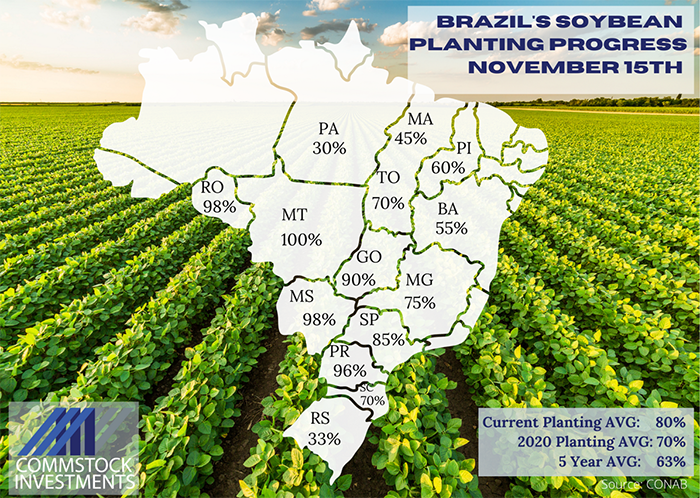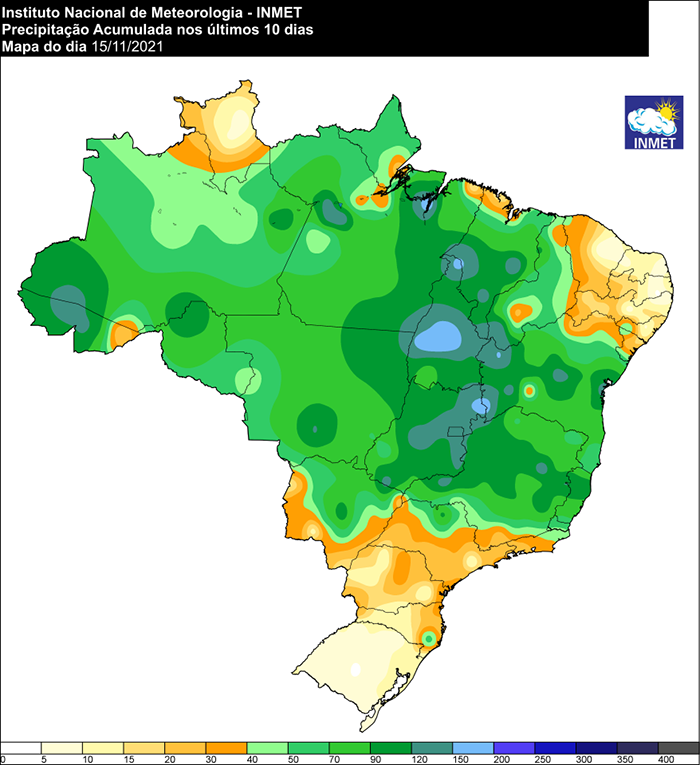
Brazil soybean planting progress now exceeds 80%. With Mato Grosso finished along with much of the Center West region, most of what remains to be planted is found in Rio Grande do Sul (33% complete) to the South, along with the northeast region of Brazil, referred to as MAPITOBA.
It’s been a successful planting season to date, and that’s why CONAB, the Brazilian government's food supply and statistics agency, increased soybean crop prospects to 142 MMT, up from 140.8 MMT. This still falls short of where the USDA has had the Brazilian crop, pegged at 144 MMT for the past several months.

The ten-day rainfall accumulation shows heavy rain occurring over most of Central Brazil. However, rainfall has been lacking in Southern Brazil, especially in Rio Grande do Sul. First crop of corn that was planted in late August/early September is already reaching pollination and so rainfall will be critical. It could also impact soybean germination as soybeans are only one-third of the way planted in that state.
Forecasts show a chance of showers coming later in the week and so that will need to materialize -- otherwise crop conditions will begin to deteriorate in that state. Rio Grande do Sul is projected to be the second largest producing soybean state behind Mato Grosso, representing 15% of the country’s output. Combined with neighboring states like Santa Catarina and Parana, which have also leaned drier, Southern Brazil represents over 30% of Brazil’s soybean output.

While Argentina is receiving some showers early this week, the 30-day weather anomaly continues to show drier areas spreading over most of Argentina between now and Dec. 25. While the epicenter of this dry area falls over the major growing areas of Argentina, it spills over into Southern Brazil.
The extent of this dry weather in the South could have a major impact on Brazil’s crop size in the weeks to come. However, Brazil’s projected 144 MMT crop is still easily attainable, as an excellent start to the planting season in Mato Grosso could offset any loss in Rio Grande do Sul. Similar to our August in the U.S. Corn belt, most of the bean crop in Mato Grosso will be made in late December/January timeframe as beans fill their pods.
Matthew Kruse is President of Commstock Investments. He can be reached at [email protected].
Futures trading involves risk. The risk of loss in trading futures and/or options is substantial and each investor and/or trader must consider whether this is a suitable investment. Past performance is not indicative of future results. Trading advice is based on information taken from trades and statistical services and other sources that CommStock Investments believes to be reliable. We do not guarantee that such information is accurate or complete and it should not be relied upon as such. Trading advice reflects our good faith judgment at a specific time and is subject to change without notice. There is no guarantee that the advice we give will result in profitable trades.
Read more about:
BrazilAbout the Author(s)
You May Also Like






